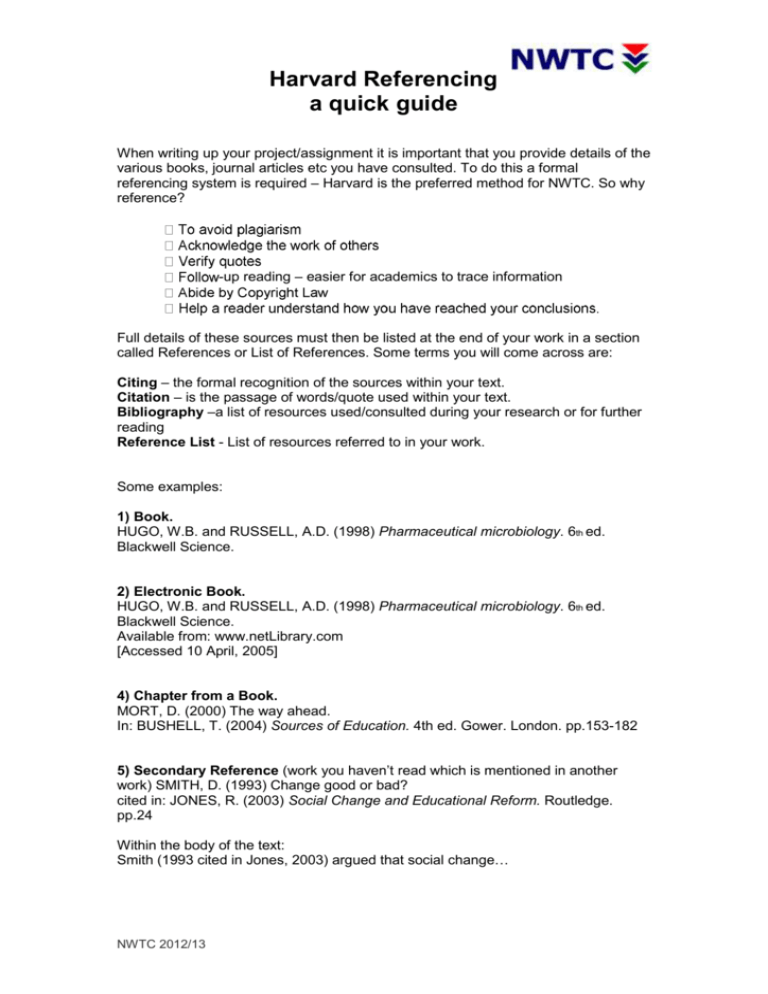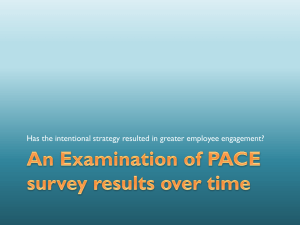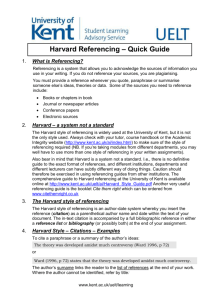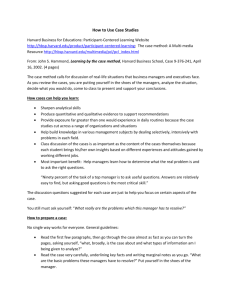Havard Referencing a quick guide
advertisement

Harvard Referencing a quick guide When writing up your project/assignment it is important that you provide details of the various books, journal articles etc you have consulted. To do this a formal referencing system is required – Harvard is the preferred method for NWTC. So why reference? -up reading – easier for academics to trace information Full details of these sources must then be listed at the end of your work in a section called References or List of References. Some terms you will come across are: Citing – the formal recognition of the sources within your text. Citation – is the passage of words/quote used within your text. Bibliography –a list of resources used/consulted during your research or for further reading Reference List - List of resources referred to in your work. Some examples: 1) Book. HUGO, W.B. and RUSSELL, A.D. (1998) Pharmaceutical microbiology. 6th ed. Blackwell Science. 2) Electronic Book. HUGO, W.B. and RUSSELL, A.D. (1998) Pharmaceutical microbiology. 6th ed. Blackwell Science. Available from: www.netLibrary.com [Accessed 10 April, 2005] 4) Chapter from a Book. MORT, D. (2000) The way ahead. In: BUSHELL, T. (2004) Sources of Education. 4th ed. Gower. London. pp.153-182 5) Secondary Reference (work you haven’t read which is mentioned in another work) SMITH, D. (1993) Change good or bad? cited in: JONES, R. (2003) Social Change and Educational Reform. Routledge. pp.24 Within the body of the text: Smith (1993 cited in Jones, 2003) argued that social change… NWTC 2012/13 Harvard Referencing a quick guide 6) Journal Article/Newspaper Article. Some Lecturers prefer the title of the article to be enclosed in inverted commas. COSGROVE, D. and JACKSON, P. (2001) “New directions in sport science.” American Scientist and Sport Vol.8, pp.103-167 N.B. List up to three authors. When more, list first author only and add et al or and others 7) Electronic Journal Article/Newspaper Article. Some Lecturers prefer the title of the article to be enclosed in inverted commas. MARTIN, E.W. (2000) “The legislative history of special education.” The future of children Vol.6 (4), pp.49-63 [online] Available from: www.futureofchildren.org [Accessed 29th October, 2002] 8) Journal Article from electronic journal service (database) COLQUHOUN, M.C. (2002) Defibrillation by general practitioners. Resuscitation [online] v.52 (2), February, pp.143-148 Available at: http://www.sciencedirect.com/ [Accessed 24th July 2002] 9) Official Publications. Act Children Act 1989, (c.41). [online] HMSO1989 Available from: www.hmso.gov.uk [Accessed: 29th January, 2005] Government Report DEPARTMENT OF EDUCATION (1996) Special needs. HMSO. Command Papers HOME OFFICE, (1978) Reform for the Official Secrets Act 1911. (Cmnd.7285) H.M.S.O. Statistical Series OFFICE OF POPULATION, (1990) General Survey for 1988 No.19. HMSO. Ofsted Report BURKE,B. (1995) Inspection under section 9 of the Education (Schools) Act 1994: Bedford High School, Manchester Road, Leigh. WN7 2TY Available at: http://www.ofsted.gov.uk/ [Accessed 26th November 2002] NWTC 2012/13 Harvard Referencing a quick guide 10) Video/DVD/Film/CD. Meetings bloody meetings. (1992) Video. Miramax. Some like it hot. (1959). Film, directed by Billy Wilder. USA, United Artists. SHOSTAKOVICH, D. (1959) Cello concerto no.1, performed by Maria Klieg & Polish National Symphony Orchestra, conducted by Antoni Wit. CD. Sony. 11) TV Programme. The Nuclear Age, Episode 3: Europe goes nuclear. UK, ITV 26th October, 1988. 12) Live Performance – Dance. CHOREOGRAPHER. (date of premier) Title. [Date seen and where]. ALSTON. R. (22nd June, 1990) Soda Lake [19th September, 2003 Covent Garden] 13) Web page. LEARNING AND INFORMATION SERVICES (2002) Guide to the Harvard Referencing System. Available from: http://www.ljmu.ac.uk/lea/78127.htm [Accessed: 10th July, 2004] Nursing theory 2000. Available from: www.ualberta.ca/~jrnorris/nt/theory.html [Accessed: 18th July 2004] 12) Electronic Images. In your reference list: The lunar interior [image] 1999. PlanetScapes, USA. Available from: www.planetscapes.com/solar/browse/moon/mooint.jpg [Accessed on: 31st January, 2003] In the body of a paragraph: When looking at the image “The lunar interior” (1999) it is obvious that…… etc, etc. If you have inserted the image into your essay then under the image: (The lunar interior, 1999) NWTC 2012/13 Harvard Referencing a quick guide 13) Dictionaries and Encyclopaedias If an encyclopaedia entry has a named author then the format for a chapter in a book should be used in addition to the encyclopaedia volume number. AUTHOR(S) (year). Title of chapter. AUTHOR(S)/EDITOR ed(s). Title Volume (if applicable), Edition. Place of publication: Publisher, Pages. (use p. or pp.) Kesner, R.P. (2000). Memoryneurobiology. In: RAMACHANDRAN, V.S. Encyclopaedia of the human brain, Vol 2. San Diego: Academic Press, pp. 783-796 Quotations. A quotation helps you support an argument and illustrate the range of your research. However, before including a quotation, stop to consider is it relevant? It is important that: It is easily identifiable Produced exactly as in the original including spelling/grammar errors Use square brackets [ ] around any words you add Use 3 dots … to indicate omissions (see examples) Three lines or less should be in quotation marks and included in the body of the essay followed by the author and page number (see example 1) Longer quotes should be an indented paragraph without quotation marks around (see example 2) Some examples: 1. “…their pay, including those referred to as fringe…” Titmuss (1958, p.51) 2. Titmuss (1958) said controversially that: their pay, including those referred to as fringe…pensions for employees, wives and dependants: child allowances; death duties; travel; entertainment; health…and an incalculable variety if benefits of kind ranging from the most tangible. (p.51) NWTC 2012/13 Harvard Referencing a quick guide Finally…. references to books, journal articles, etc. are presented in: a single sequence arranged alphabetically by author. References to materials by the same author are arranged by their date of publication. Book titles or journal titles (not article) are normally underlined or in italics Page numbers are included in reference list and bibliography entries for journal articles and essays only. To add a note insert number in text - (1) [1] ¹ etc at the appropriate point and use footnote for reference or include the note before the Reference List. Make sure any resource referred to in your work is in the Reference List Do not include everything consulted in your Bibliography– discriminate between important & less significant sources. Make a note of resources as you use them to save time. BE CONSISTENT!! This guide is not a definitive document on Harvard References and some lecturers have particular preferences regarding presentation - always seek guidance and clarification from your lecturer. For further details of the Harvard system please refer to the full Harvard referencing system. NWTC 2012/13





